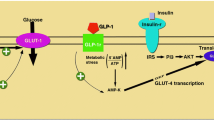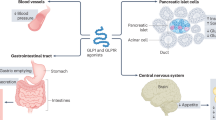Abstract
Although the insulinotropic role of glucagon-like peptide-1 (GLP-1) in type 2 diabetes mellitus has been substantiated, its role in cardioprotection remains largely unknown. To ascertain the role of the cardiovascular actions of GLP-1 in health and disease states necessitates a review of the current evidence as well as ongoing investigation. Of cardiovascular significance, both positive inotropic and chronotropic effects, unmodifiable by gB-adrenergic blockers, have been reportedly attributed to GLP-1 actions on the myocardium. However, the potent role of GLP-1 and its analogues in eliciting tachycardic and pressor effects should be of some concern. Aside from its reported insulinotropic activity, GLP-1 impacts the myocardium directly. Highly specific GLP-1 receptors have been identified in the heart and within the central nervous system, particularly in the nucleus tractus solitarius, a neuromodulatory centre of cardiovascular control. The occurrence of GLP-1 receptors in cardiac tissue and autonomic regions of cardiovascular control has stimulated investigation, particularly as these sites may be suitable targets for the pharmacological action of GLP-1 and long-acting analogues. Discordance on the haemodynamic consequences of GLP-1 pharmacotherapy in experimental animals and human patients has been reported in the literature. However, longterm pharmacological doses of GLP-1 have shown prolonged and beneficial actions on cardiovascular homeostasis in the adjuvant treatment of metabolic disease.
Similar content being viewed by others
References
Brubaker PL. Glucagon-like peptide-1: a novel therapeutic agent for the treatment of type 2 diabetes. Can J Diab Care 1999; 23: 39–46
Drucker DJ. Glucagon-like peptides. Diabetes 1997; 47: 159–69
Yu M, Moreno C, Hoagland KM, et al. Antihypertensive effect of glucagon-like peptide 1 in Dahl salt-sensitive rats. J Hyper-tension 2003; 21: 1125–35
Yamamoto H, Lee CE, Marcus JN, et al. Glucagon-like peptide-1 receptor stimulation increases blood pressure and heart rate and activates autonomic regulatory neurons. J Clin Invest 2002; 110: 43–52
Creutzfeldt WO, Kleine N, Willms B, et al. Glucagonostatic actions and reduction of fasting hyperglycemia by exogenous glucagon-like peptide 1 (7-36) amide in type 1 diabetic patients. Diabetes Care 1996; 19: 580–6
Gutniak M, Orskov C, Holst JJ, et al. Antidiabetogenic effect of glucagon-like peptide-1 (7-36) amide in normal subjects and patients with diabetes mellitus. N Engl J Med 1992; 326: 316–22
D’Alessio DA, Prigeon RL, Ensinck JW. Enteral enhancement of glucose disposition by both insulin-dependent and insulin-independent processes: a physiological role of glucagon-like peptide 1. Diabetes 1995; 44: 1433–7
Flint A, Raben A, Astrup A, et al. Glucagon-like peptide 1 promotes satiety and suppresses energy intake in humans. J Clin Invest 1998; 101: 515–20
Willms B, Werner J, Holst JJ, et al. Gastric emptying, glucose responses, and insulin secretion after a liquid test meal: effects of exogenous glucagon-like peptide-1 (GLP-1)-(7-36) amide in type 2 (noninsulin-dependent) diabetic patients. J Clin En-docrinol Metab. 1996; 81: 327–32
Juntti-Berggren L, Pigon J, Karpe F, et al. The antidiabetogenic effect of GLP-1 is maintained during a 7-day treatment period and improves diabetic dyslipoproteinemia in NIDDM patients. Diabetes Care. 1996; 19: 1200–6
De Leon DD, Crutchlow MF, Ham JYN, et al. Role of glucagonlike peptide-1 in the pathogenesis and treatment of diabetes mellitus. Int J Biochem Cell Biol 2006; 38: 845–59
Young AA, Gedulin BR, Bhavsar S, et al. Glucose-lowering and insulin-sensitizing actions of exendin-4. Diabetes 1999; 48: 1026–34
Luque MA, Gonzalez N, Marquez L, et al. Glucagon-like peptide-1 (GLP-1) and glucose metabolism in human myocytes. J Endocrinol 2002; 173: 465–73
Vila Petroff MGV, Egan JM, Wang X, et al. Glucagon-like peptide-1 increases cAMP but fails to augment contraction in adult rat cardiac myocytes. Circ Res 2001; 89: 445–52
Egan JM, Montrose-Rafizadeh C. Wang Y, et al. Glucagon-like peptide-1 (7-36) amide (GLP-1) enhances insulin-stimulated glucose metabolism in 3t3-l1 adipocytes: one of several poten-tial extrapancreatic sites of GLP-1 action. Endocrinology 1994; 135: 2070–5
Bose AK, Mocanu MM, Carr RD, et al. Glucagon-like peptide 1 can directly protect the heart against ischemia/reperfusion injury. Diabetes 2005; 54: 146–51
Gros R, You X, Baggio LL, et al. Cardiac function in mice lacking the glucagon-like peptide-1 receptor. Endocrinology 2003; 144: 2242–52
Baggio LL, Drucker DJ. American Diabetes Association 66th Scientific Sessions. Incretin analogs other than Exenatide [online]. Available from URL: http://www.medscape.com/viewarticle/540919/ [Accessed 2006 Nov 21]
Cornell S. LAF 237: a dipeptidyl peptidase IV (DPP-4) inhibitor for the treatment of type 2 diabetes mellitus. J Pharm Technol 2006; 22: 1–5
Hui H, Farilla L, Merkel P, et al. The short half-life of glucagon-like peptide-1 in plasma does not reflect its long-lasting benefi-cial effects. Eur J Endocrinol. 2002; 146: 863–9
Nikolaidis LA, Elahi D, Shen YT, et al. Active metabolite of GLP-1 mediates myocardial glucose uptake and improves left ventricular performance in conscious dogs with dilated cardio-myopathy. Am J Physiol 2005; 289: H2401–8
Taegtmeyer H. Cardiac metabolism as a target for the treatment of heart failure. Circulation 2004; 110: 894–6
Barragan JM, Rodriguez RE, Eng J, et al. Interactions of exendin-(9-39) amide and of exendin-4 on arterial blood pressure and heart rate in rats. Regul Pept 1996; 67: 63–8
Nystrom T, Gutniak MK, Zhang Q, et al. Effects of glucagonlike peptide-1 on endothelial function in type 2 diabetes pa-tients with stable coronary artery disease. Am J Physiol 2004; 287: E1209–15
Buyukcoskun NI, Gulec G. Effects of intracerebroventricularly injected glucagon-like peptide-1 on cardiovascular parameters; role of central cholinergic system and vasopressin. Regul Pept 2004; 118: 33–8
Barragan JM, Rodriguez RE, Blazquez E. Changes in arterial blood pressure and heart rate induced by glucagon-like pep-tide-1-(7-36) amide in rats. Am J Physiol 1994; 266: E459–66
Gardiner SM, March JE, Kemp PA, et al. Mesenteric vasoconstriction and hindquarters vasodilatation accompany the pres-sor actions of exendin-4 in conscious rats. J Pharmacol Exp Ther 2006; 316: 852–9
Nikolaidis LA, Elahi D, Hentosz T, et al. Recombinant glucagon-like peptide-1 increases myocardial glucose uptake and improves left ventricular performance in conscious dogs with pacing-induced dilated cardiomyopathy. Circulation 2004; 110: 955–61
Barragan JM, Eng J, Rodriguez R, et al. Neural contribution to the effect of glucagon-like peptide-1-(7-36) amide on arterial blood pressure in rats. Am J Physiol 1999; 277: E784–91
Edwards CMB, Edwards AV, Bloom SR. Cardiovascular and pancreatic endocrine responses to glucagon-like pep-tide-1(7-36) amide in the conscious calf. Exp Physiol 1997; 82: 709–16
Zhao T, Parkkh P, Bhashyam S, et al. Direct effects of glucagon-like peptide-1 on myocardial contractility and glucose uptake in normal and postischemic isolated rat hearts. J Pharmacol Exp Ther 2006; 317: 1106–13
Wei Y, Mojsov S. Tissue-specific expression of the human receptor for glucagon-like peptide-1: brain, heart and pancreatic forms have the same deduced amino acid sequences. FEBS Lett 1995; 358: 219–24
Nystrom T, Gonon AT, Sjoholm A, et al. Glucagon-like peptide-1 relaxes rat conduit arteries via an endothelium-indepen-dent mechanism. Regul Pept 2005; 125: 173–7
Kavianipour M, Ehlers MR, Malmberg K, et al. Glucagon-like peptide-1 (7–36) amide prevents the accumulation of pyruvate and lactate in the ischemic and non-ischemic porcine myocar-dium. Peptides 2003; 24: 569–78
Toft-Nielsen MB, Madsbad S, Holst JJ. Continuous subcutaneous infusion of glucagon-like peptide 1 lowers plasma glucose and reduces appetite in type 2 diabetic patients. Diabetes Care 22: 1999, 1143
Vilsboll T, Zdravkovic M, Le-Thi T, et al. Liraglutide treatment, blood pressure and biomarkers of cardiovascular risk in pa-tients with type 2 diabetes: 14 weeks monotherapy study. In: Program and abstracts of the American Diabetes Association 66th Scientific Sessions; 2006 June 9–13; Washington (DC). Diabetes 2006; 55 Suppl. 1: 2007–PO
Thrainsdottir I, Malmberg K, Olsson A, et al. Initial experience with GLP-1 treatment on metabolic control and myocardial function in patients with type 2 diabetes mellitus and heart failure. Diab Vasc Res 2004; 1: 40–3
Kapitza C, Heise T, Klein O, et al. BIM51077, a novel GLP-1 analog, achieves sustained improvement in blood glucose con-trol over 28 days of treatment. In: Program and abstracts of the American Diabetes Association 66th Scientific Sessions; 2006 June 9–13; Washington (DC). Diabetes 2006; 55 Suppl. 1: 500–P
Thibaudeau K, Robitaille M, Wen S, et al. CJC-1134-PC: An exendin-4 conjugate with extended pharmacodynamic profiles in rodents. In: Program and abstracts of the American Diabetes Association 66th Scientific Sessions; 2006 June 9–13; Wash-ington (DC). Diabetes 2006; 55 Suppl. 1: 434–P
Baggio LL, Huang Q, Drucker DJ. The long-acting albuminexendin-4 GLP-1R agonist CJC-1134 engages central and peripheral mechanisms regulating glucose homeostasis. In: Program and abstracts of the American Diabetes Association 66th Scientific Sessions; 2006 June 9–13; Washington (DC). Diabetes 2006; 55 Suppl. 1: 362–OR
Golpon HA, Puechner A, Welte T, et al. Vasorelaxant effect of glucagon-like peptide-(7-36) amide and amylin on the pulmo-nary circulation of the rat. Regulatory Peptides 2001; 102: 81–6
Acknowledgements
No sources of funding were used to assist in the preparation of this review. The authors have no conflicts of interest that are directly relevant to the content of this review.
Author information
Authors and Affiliations
Corresponding author
Rights and permissions
About this article
Cite this article
Saraceni, C., Broderick, T.L. Effects of Glucagon-Like Peptide-1 and Long-Acting Analogues on Cardiovascular and Metabolic Function. Drugs R D 8, 145–153 (2007). https://doi.org/10.2165/00126839-200708030-00002
Published:
Issue Date:
DOI: https://doi.org/10.2165/00126839-200708030-00002




